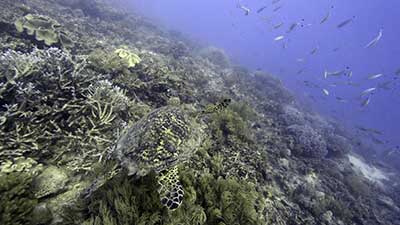Date : 20/06/2023
Relevance –
- GS Paper 2 - International Organization
- GS Paper 3 - Environment - Conservation Efforts
Keywords - United Nations, High Seas, territorial water, marine genetic resources
Context –
The 193 U.N. member nations have adopted the first-ever treaty to protect marine life in the high seas. The United Nations chief hailed the historic agreement saying it gives the ocean “a fighting chance.
About United Nations –
- The United Nations is an international organization founded in 1945. Currently made up of 193 Member States, the UN and its work are guided by the purposes and principles contained in its founding Charter.
- The UN has evolved over the years to keep pace with a rapidly changing world.
Urgent Need for Ocean Conservation
- Given that oceans play a crucial role in producing most of the world's oxygen and absorbing carbon dioxide, their protection becomes increasingly critical in curbing carbon emissions and combating global warming. Astonishingly, only 1% of the vast ocean areas are currently safeguarded.
Over Two Decades of Negotiations Culminate in Success
- Deliberations surrounding a treaty to safeguard biodiversity in the high seas, which constitute nearly half of the Earth's surface, had been ongoing for more than 20 years. However, efforts had repeatedly stalled until March, when delegates to a U.N. General Assembly-established intergovernmental conference finally reached an agreement. Subsequently, the treaty underwent legal scrutiny and was translated into the U.N.'s six official languages.
Key Provisions of the Treaty
- The forthcoming treaty, scheduled for signing on September 20 during the annual meeting of world leaders at the General Assembly, will take effect upon ratification by 60 countries.
- Notably, it establishes a new governing body responsible for managing the conservation of ocean life and creating marine protected areas in the high seas. Additionally, the treaty lays out guidelines for conducting environmental impact assessments for commercial activities conducted in oceanic regions.
What are high seas?
- The United Nations define high seas as “The parts of the sea that do not include the internal water of a state”. Internal waters are territorial waters. In other words, these waters are used by a country. The country may use it for any purpose like fishing, oil drilling, etc.
What is included in the high seas?
- The high seas are also called transboundary waters or international waters. It includes marine ecosystems, estuaries, rivers, regional seas, groundwater systems, wetlands, etc. No country shall profess sovereignty over the high seas.
U.N. Secretary-General Stresses the Timeliness of the Treaty
- Secretary-General Antonio Guterres emphasized the critical importance of adopting the treaty in light of the numerous threats faced by the world's oceans. Climate change-induced disruptions to weather patterns, ocean currents, rising sea temperatures, and alteration of marine ecosystems pose significant challenges. Overfishing, over-exploitation, and ocean acidification further endanger marine biodiversity. Guterres urged countries to spare no effort in signing and ratifying the treaty promptly, underscoring its crucial role in addressing these threats and protecting the ocean.
Fair Access to Marine Genetic Resources
- The treaty also addresses the principle of sharing "marine genetic resources" discovered by scientists in international waters. Developing countries, in particular, demanded that the benefits of such discoveries should not be solely controlled by wealthier nations capable of financing expeditions aimed at finding potentially valuable ingredients for medicine and cosmetics.
Global Support and Contention
- Following the treaty's approval, the Group of 77, a U.N. coalition consisting of 134 primarily developing nations and China, hailed the day as "exceedingly important for biodiversity." They commended the inclusion of benefit-sharing and funding provisions in the final text to aid in the treaty's implementation after ratification. Meanwhile, the Alliance of Small Island States, whose members face the imminent threat of climate change and rising sea levels, expressed their long-standing advocacy for the treaty, highlighting its far-reaching implications for their livelihoods, cultures, and economies.
Russian Dissent Raises Objections
However, Russia took a contrary stance and distanced itself from the consensus on the treaty's text. Labeling it "unacceptable," Russia contended that the agreement undermined the provisions of critical existing international agreements, including the U.N. Convention on the Law of the Sea.
Conclusion:
The adoption of the first-ever treaty to protect marine life in the high seas marks a historic milestone in global efforts to safeguard our oceans. With overwhelming support from member nations, the treaty's approval received resounding applause and a standing ovation, reflecting the recognition of the urgent need for ocean conservation. By establishing a new governing body, creating marine protected areas, and setting guidelines for environmental impact assessments, the treaty lays the foundation for comprehensive measures to address the threats faced by marine ecosystems.
Probable Questions For Mains Examination
- Question 1. Assess the significance of the United Nations treaty adopted to safeguard marine life in the high seas. Examine the key provisions of the treaty and its potential implications for global ocean conservation efforts. Also, discuss the challenges and controversies surrounding the treaty, considering the dissenting stance of Russia. (10 Marks, 150 words)
- Question 2. Critically analyze the urgency and necessity of adopting the United Nations treaty for the protection of marine life in the high seas. Evaluate the role of the treaty in addressing the threats posed by climate change, overfishing, and ocean acidification. Discuss the potential impact of the treaty's provisions, including the establishment of a new governing body and guidelines for environmental impact assessments. (15 Marks, 250 words)
Source – Aljazeera, Forbes, Abcnews








